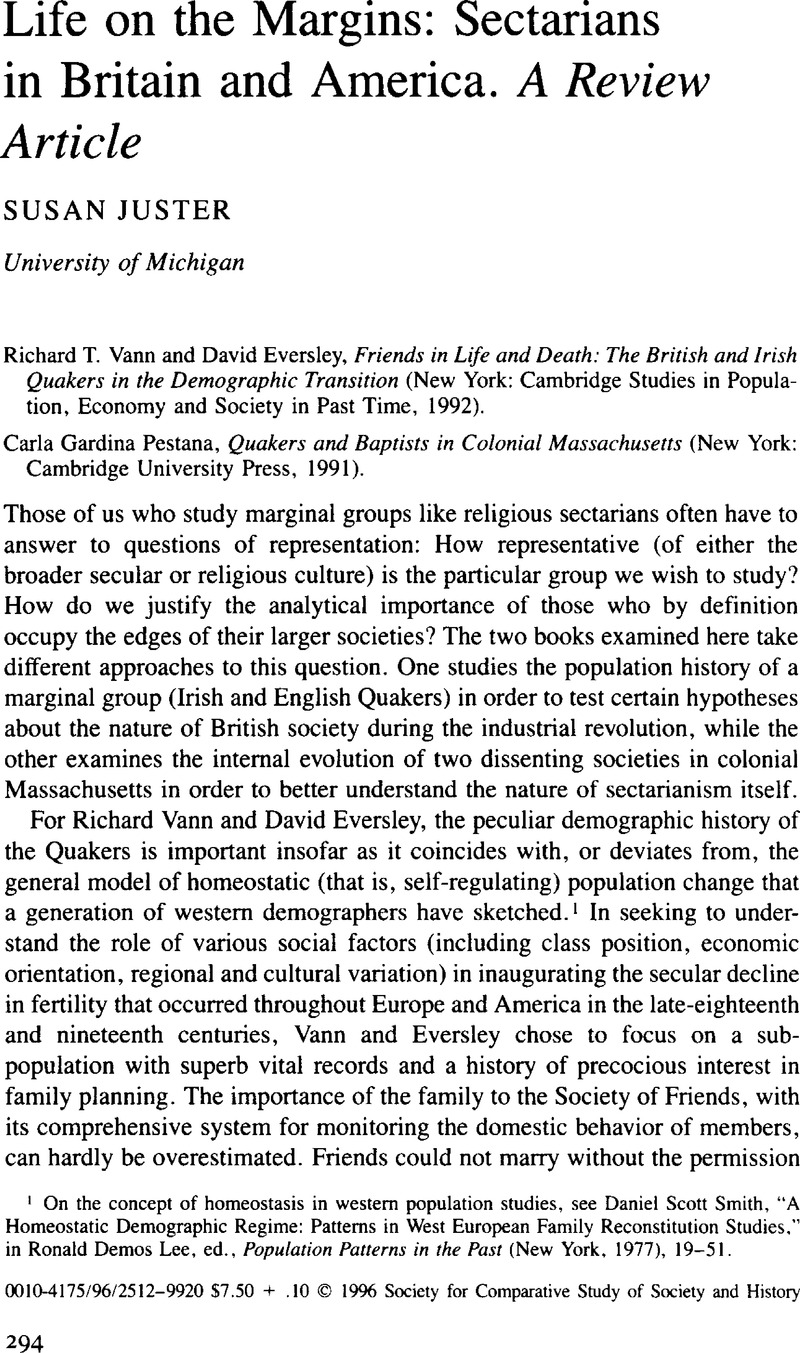No CrossRef data available.
Article contents
Life on the Margins: Sectarians in Britain and America. A Review Article
Published online by Cambridge University Press: 03 June 2009
Abstract

- Type
- The Missions of Religion
- Information
- Copyright
- Copyright © Society for the Comparative Study of Society and History 1996
References
1 On the concept of homeostasis in western population studies, see Daniel Scott Smith, “A Homeostatic Demographic Regime: Patterns in West European Family Reconstitution Studies.” in Lee, Ronald Demos, ed., Population Patterns in the Past (New York, 1977), 19–51Google ScholarPubMed.
2 For a discerning discussion of the different reasons that men and women put forward for limiting childbearing in ante-bellum southern families, see Lockridge, Kenneth and Lewis, Jan, “‘Sally Has Been Sick': Pregnancy and Family Limitation Among Virginia Gentry Women, 1780–1830, Journal of Social History, 22 (Fall 1988), 5–19Google Scholar.
3 Phyllis Mack and Jack Marietta have also described Quakerism as a “feminine” religious culture. See Mack, , Visionary Women: Ecstatic Prophecy in Seventeenth-Century England (Berkeley, 1992)Google Scholar, and Marietta, , The Reformation of American Quakerism, 1748–1783 (Philadelphia, 1984)Google Scholar.
4 See, for example, John Knodel's studies of the fertility transition in Germany which conclude that attempts to increase the spacing between births were not a significant factor in limiting fertility (“Demographic Transitions in German Villages,” in Fertility Decline in Europe, Watkins, Susan and Coale, A. J., eds. [Princeton, 1985]Google Scholar and“Starting, Stopping, and Spacing during the Early Stages of the Fertility Transition: The Experience of German Village Populations in the 18th and 19th Centuries,” Demography, 24 [1987], 143–62)CrossRefGoogle ScholarPubMed. concurs, Wally Secombe, in “Starting to Stop: Working-Class Fertility Decline in Britain,” Past and Present, 126 (1990)Google Scholar. Bean, Lee L. et al., Fertility Change on the American Frontier: Adaptation and Innovation (Berkeley, 1990)Google Scholar, make the revisionist argument that fertility control could have been effected by child spacing.
5 Porterfield, , Female Piety in Puritan New England: The Emergence of Religious Humanism (New York, 1992)Google Scholar. See also Schweitzer, Ivy, The Work of Self-Representation: Lyric Poetry in Colonial New England (Chapel Hill, 1991)Google Scholar; Masson, Margaret, “The Typology of the Female as a Model for the Regenerate: Puritan Preaching, 1690–1730,” Signs: A Journal of Women in Culture and Society, 2 (1976), 304–15CrossRefGoogle Scholar; and Greven, Philip, The Protestant Temperament: Patterns of Child-Rearing, Religious Experience, and the Self in Early America (New York, 1980)Google Scholar on the “feminized” aspects of Puritan faith in the seventeenth century.
6 This point was made more fully in Pestana's earlier article, “The City Upon a Hill Under Siege: Puritan Perceptions of the Quaker Threat to Massachusetts Bay 1656–1661,” New England Quarterly, 5 (September 1983), 323–53Google Scholar. I should add that both Quakers and Baptists represented a feminized version of reformed faith to Puritan authorities, despite the latter's belief in what Pestana has labelled “masculine” practices (biblical exegesis and predestinarian theology). In celebrating the supremely individual nature of man's relationship to God, disentangled from all social conventions of status and rank, Baptists presented a feminized understanding of grace that was recognized as such by those in positions of ecclesiastical authority. This idea is developed further in Juster, , Disorderly Women: Sexual Politics and Evangelicalism in Revolutionary New England (Ithaca, 1994)Google Scholar.




